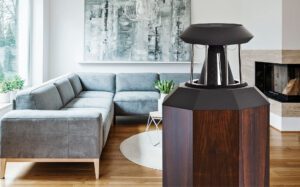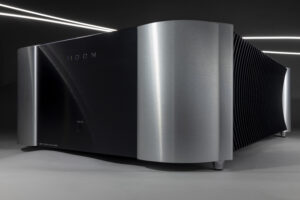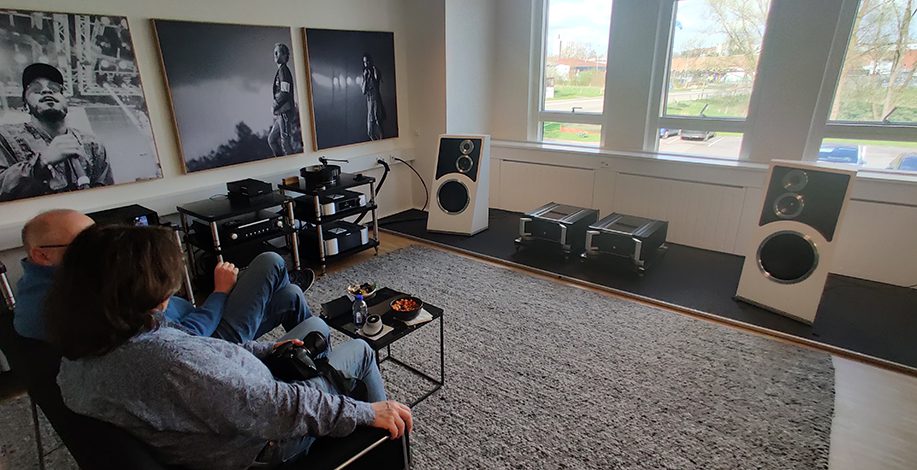
Visiting Audiovector’s headquarters on the outskirts of Copenhagen is, in many ways, a refreshing and simultaneously heartwarming experience. There is an open-plan office, two demo rooms referred to as the ‘big’ and the ‘small’ rooms, a kitchen that includes a chilled wine cabinet (more of that later on), and friendly faces all around. There is also no ‘death by PowerPoint’ depicting market strategies and outside capital investment ‘needed’ to enter the next growth stage.
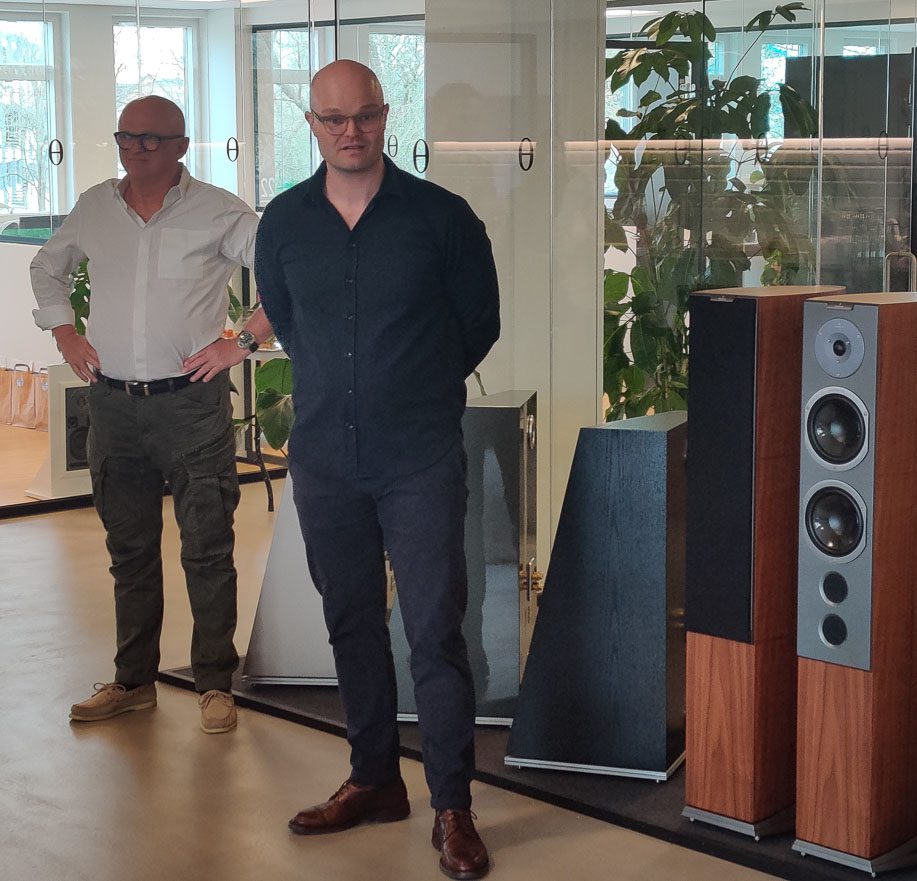
“I’m not planning to change anything,” says CEO and owner Mads Klifoth, who took over the reins from father and company founder Ole Klifoth at the start of the year. “We’re not going to expand, we are not going to be taken over by a larger brand conglomerate, we are not going to launch a line of Bluetooth speakers or whatever, we are not going to outsource production to China. Neither of us is in the business of introducing new speaker lines every fortnight. We are simply happy with our size – our capacity lies in the region of 5,000 speaker pairs annually – with the staff on board and the relations with our suppliers and collaborators, pretty much all of which are in the direct vicinity of our works. It gives us the means and the freedom to do our best. So why want to change any of that?”
Planned obsolescence? Nej tak!
Looking at the quantity and quality of ancillary equipment found in any of the rooms, it’s clear that the self-effacing way in which the Klifoths go about their business is the diametric opposite of the Anglo-American model of expansion, exploitation, and planned obsolescence has gained them many friends in the industry. Every piece of equipment – from brands such as Naim, MOON, Brinkmann and Gryphon – is in place because of mutual respect and understanding between their makes and Audiovector. Customer loyalty is also something that is being cherished and rewarded – if you bought an Audiovector speaker ten or twenty years ago, you can still upgrade it to the latest specification, or you can upgrade your R-series speakers from the ‘basic’ Signature version to the upper-level Arreté – without selling them, this is not just good news from a financial perspective, but it is also more sustainable.
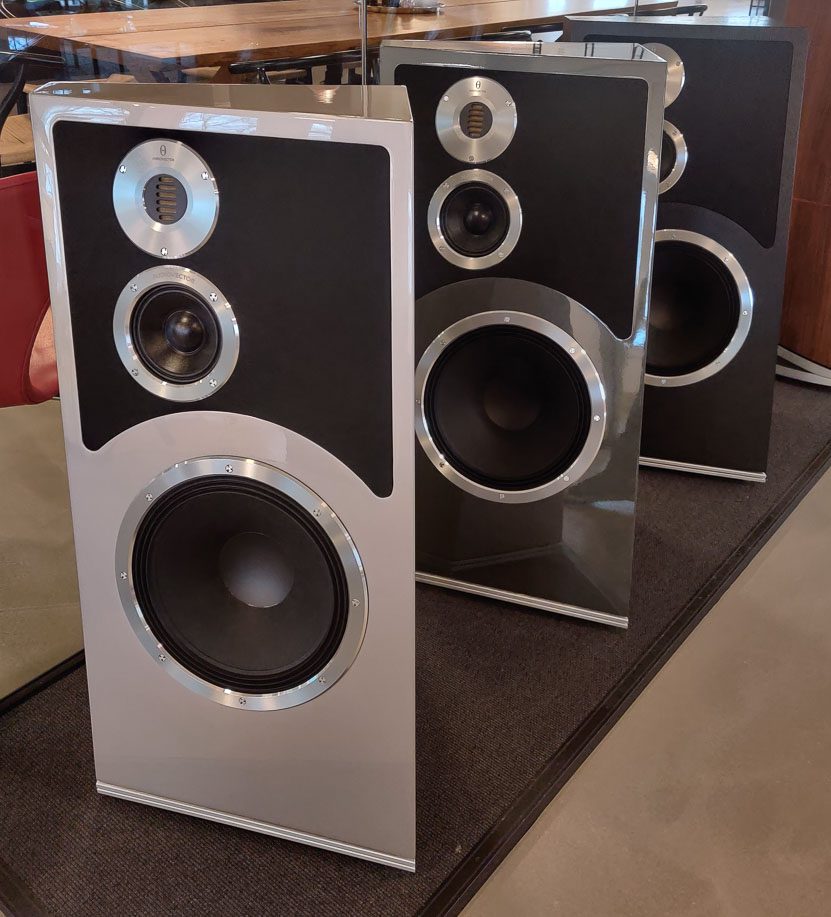
However, after many years of producing living-room-friendly slimline speakers, there has been something new and somewhat different brewing at Audiovector, something that harks back to the very beginning of the company in 1979, when Ole Klifoth launched his first commercial loudspeaker – the Trapeze. Back then, a three-way, linear phase speaker with all driver units time aligned acoustically and in positive polarity was something revolutionary and laid the groundwork for all subsequent Audiovector speakers, with their focus on linear dynamics and linear phase through true first-order crossovers for all drivers.
Iconic
However, the Trapeze’s iconic, wide-baffle, ‘lopsided’ shape didn’t translate to the later speaker lines. “After the Trapeze, we concentrated on slim, unobtrusive columns because that’s what people wanted,” says Ole Klifoth, still in charge of Audiovector speaker development at 75. “About three years ago, however, Mads came to me and said he wanted me to develop another speaker with a wide baffle and large bass driver, as he had observed a trend towards loudspeakers with a broad and relatively shallow form factor – speakers that are easy to place in a domestic environment but are not apologetic about being, well, a loudspeaker, aesthetically. So, we decided that maybe it was time to revive the Trapeze concept.
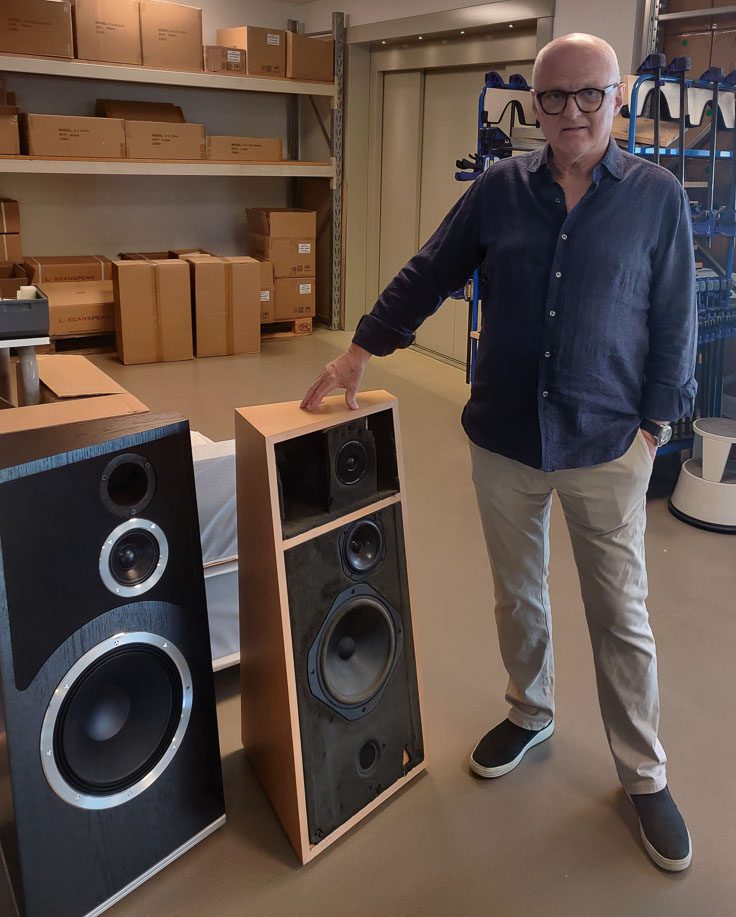
“Of course, it was clear to us that while using our very first loudspeaker design as a guide, literally everything apart from the general shape and it is a three-way, linear phase design with the acoustic centres of all three main drivers aligned on that front baffle that not only slopes from top to bottom but also from side to side, needed to be developed new from the ground up. Still, it took us way longer from start to finish than we’d expected beforehand. Once you get into that phase where you start to re-evaluate certain aspects beyond what you previously thought possible, they bring a chain of consequences, and things tend to snowball… All three drivers are brand new.”
Your starter for 12
“At the start of the project, we said we would like to use a 12-inch woofer,” Ole continued, “but ideally, it had to crossover with a very fast 5-inch midrange at about 500 Hz. With the usual half-roll rubber surround, we found that near that crossover point, the woofer might be unable to keep up with the midrange unit. This resulted in devising a new corrugated ‘concertina’ surround for the long-fibre paper cone to make sure the speed and level of detail of the large bass driver matches and seamlessly integrates with the 5-inch mid-unit – that one also got a speed-optimised concertina to surround to maximise detail. As with most of our current larger speakers, there’s an additional 8-inch driver inside that works with the 12-inch driver to couple the masses of both together in an isobaric arrangement. This achieves a low-frequency response that manages to combine speed and weight.”

High frequencies are courtesy of a purpose-designed version of Audiovector’s highly acclaimed Air Motion Transformer (AMT), the rear of which breathes through an opening in the cabinet’s back panel. To help the loudspeakers ‘disappear’ sonically, although their physical width, mid- and high-frequency drivers are surrounded by a layer of diffraction-absorbing felt.
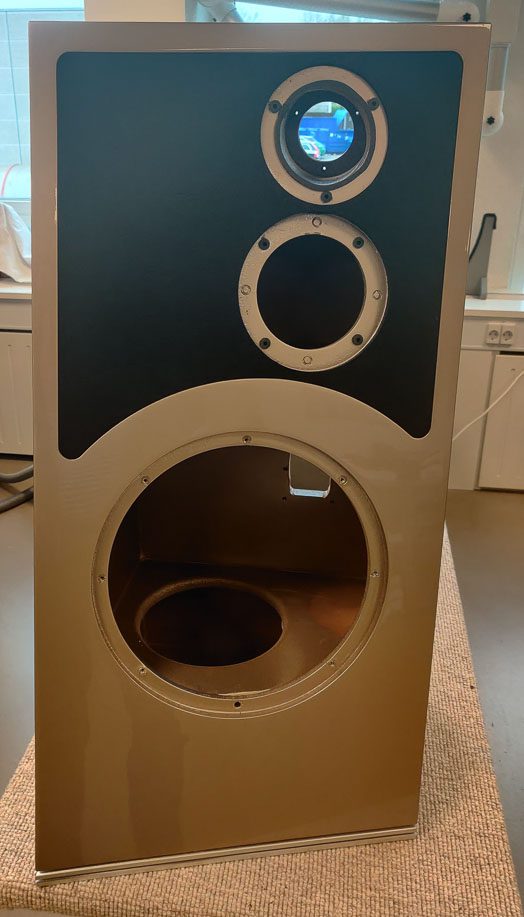
Not so complex
Although the crossover filter of the reimagined Trapeze looks reasonably (but not overly) complex at first sight, there is very little of it in the signal path: just one element per driver. Audiovector’s ‘Freedom Grounding’ concept also seeks to eliminate the movement-induced distortion of and between the drive units by separating the currents running between the chassis and routing them to the ground terminal of your wall socket or power distribution block.
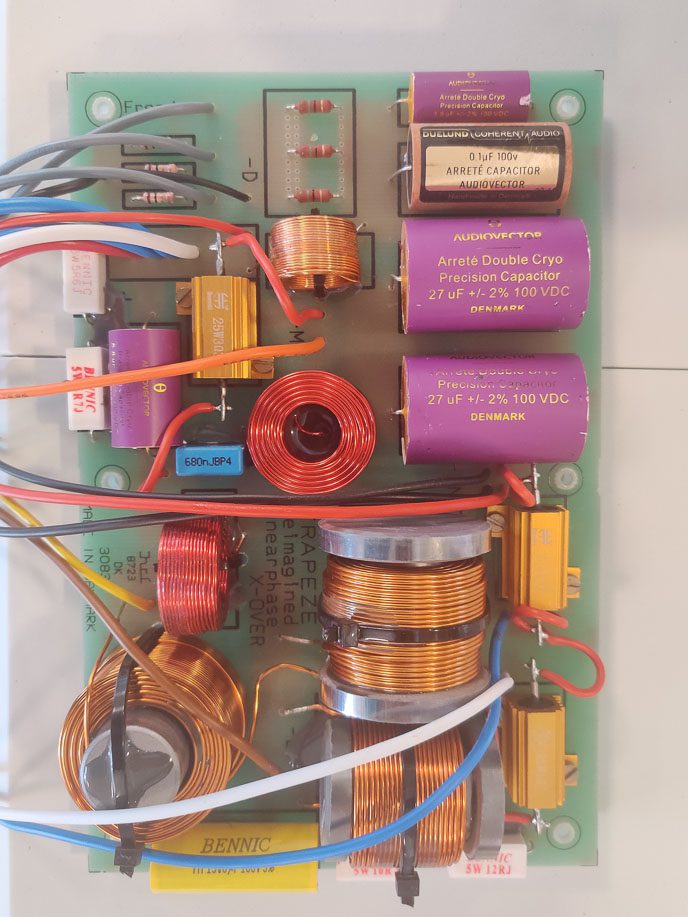
There is also a damping feature that provides a choice of three positions for matching the damping factors of different amplifier topologies – one that’s meant for ‘normal’ transistor amplifiers with a reasonably regular damping factor, one for high power/high damping factor transistor’ beasts’ like the vast Gryphon power amp used in the larger of Audiovector’s demo rooms, and one for use with tube amps with a low damping factor. This is a general guide: Trapeze Reimagined users are encouraged to try any of the three settings regardless and decide what works best for them.
Bespoke
Audiovector uses bespoke but industrially manufactured and selected crossover components to ensure the highest possible consistency. Although the double cryogenically treated polypropylene capacitors with a tin-flashed copper coil have stated variants of +/- 2%, a quick measurement of two random examples by Ole did support his claim that the typical actual variance is less than +/- 0.3 per cent…
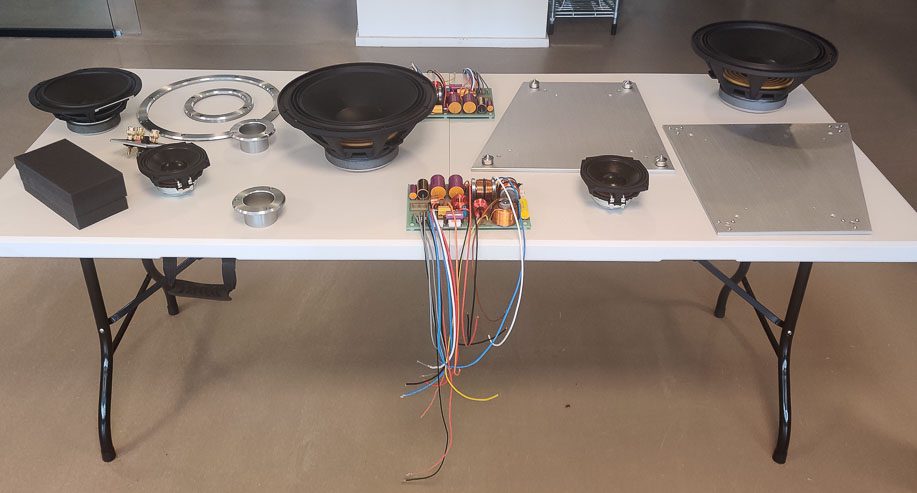
The system’s impedance is stated as 8 Ohms with a minimum of 6.5 Ohm at 20 kHz; sensitivity is rated at 88 dB/2.83 V RMS; in practice, though, Ole Klifoth surmises, it might be closer to 89 dB. “We aim to keep our speakers as free from dynamic compression as possible, so with every new speaker, I aim to eke out another half dB… It’s a difficult balancing act, though, as the wish for the best possible low-frequency extension for a given enclosure size conflicts with that goal. I can see myself doing a lot of research into developing motor systems for drivers that are much stronger still shortly.”
Cool form
One cool thing about the reimagined Trapeze’s form factor is that they can be aligned in parallel (and relatively close) to a rear wall, and the front baffles will be aimed at the listener; the recommended amount of toe-in has been ‘built-in’ and works for most combinations of distance between speakers and between the speakers’ baseline and the listening position. Not that one would recommend just plonking them in front of a wall and being done with it, but positioning the Trapeze Reimagined for optimum results is a bit easier.
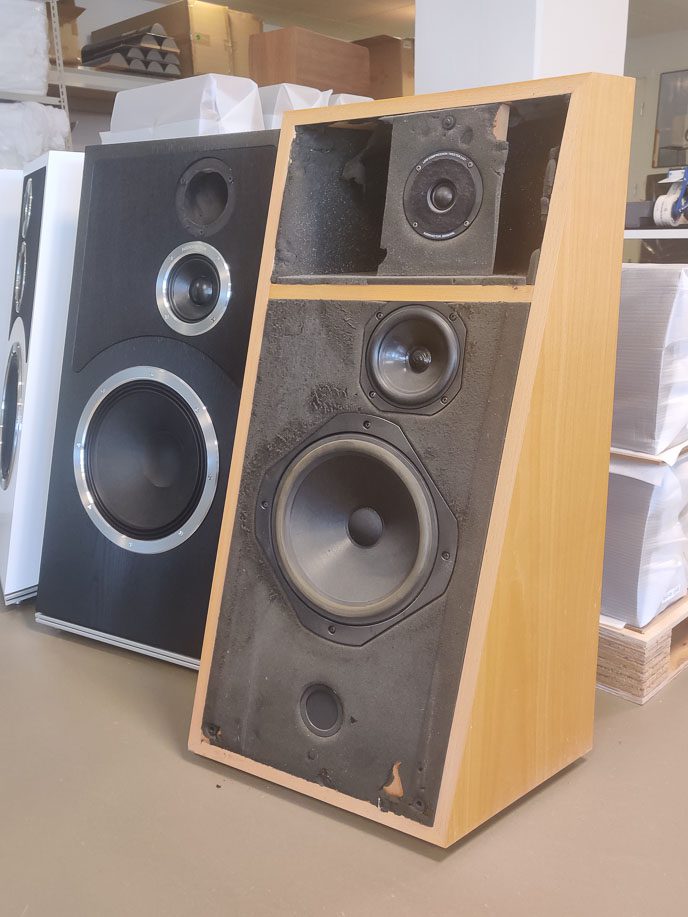
The Trapeze Reimagined cabinet is double decoupled from the floor by an elaborate two-layer aluminium plinth using carbon steel balls between both layers. The assembly is coupled to the floor via spikes on floor protection discs. Four standard finishes—Nordic Oak, Italian Walnut, Black Ash, and White Silk—are available, and you can have your Trapeze Reimagineds finished in any paint colour you like.
Future Retro
So how does the radically different form factor of this almost ‘future-retro’ model that sets it apart from the ‘regular’ Audiovector lines translate to the sound experience? First impressions are that while all the hallmarks of Audiovector DNA – an uncommon blend of clarity, detail and dynamics with warmth, depth and a sense of effortlessness – are present and correct, these are just that bit more willing to let their hair hang down, with bass that’s both ‘bigger’ and more propulsive and perhaps an enhanced sense of immediacy across the frequency range.
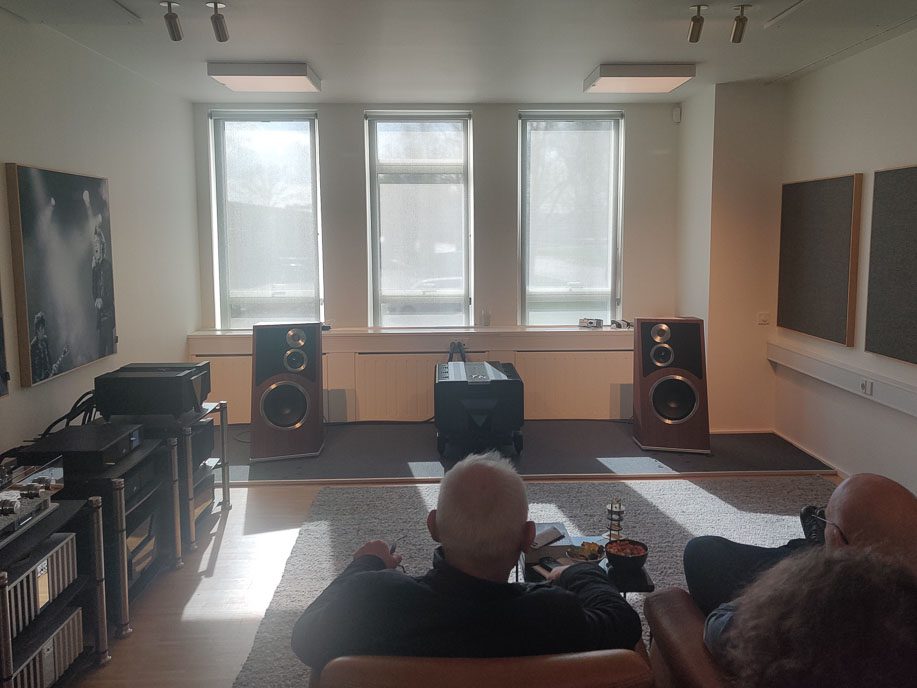
During the listening sessions we had – in the big demo room with the aforementioned giant Gryphon powerhouse and its matching pre, in the ‘small’ one with a Moon pre/power combo and using a Naim streaming front end in both – where the tablet controlling Tidal’s music library went from one pair of hands into another, without any interference from the Audiovector staff apart from a short presentation with a handful of music examples in either demo room at the beginning, you could sense the music choices becoming more exuberant – from Nightwish playing Phantom of the Opera via various bits of ’80s pop and techno to AC/DC’s Hells Bells as a finale when we should have been long sat in the coach to our hotel, the volume getting cranked up higher and the smiles getting bigger.
Isn’t that what music is supposed to be all about? At a projected price level of €17,000 per pair, as production is ramping up for a public launch coinciding with the Munich High-End show, this is definitely one to watch!
Manufacturer
Audiovector
Tags: AUDIOVECTOR TRAPEZE REIMAGINED FLOORSTANDING LOUDSPEAKER








